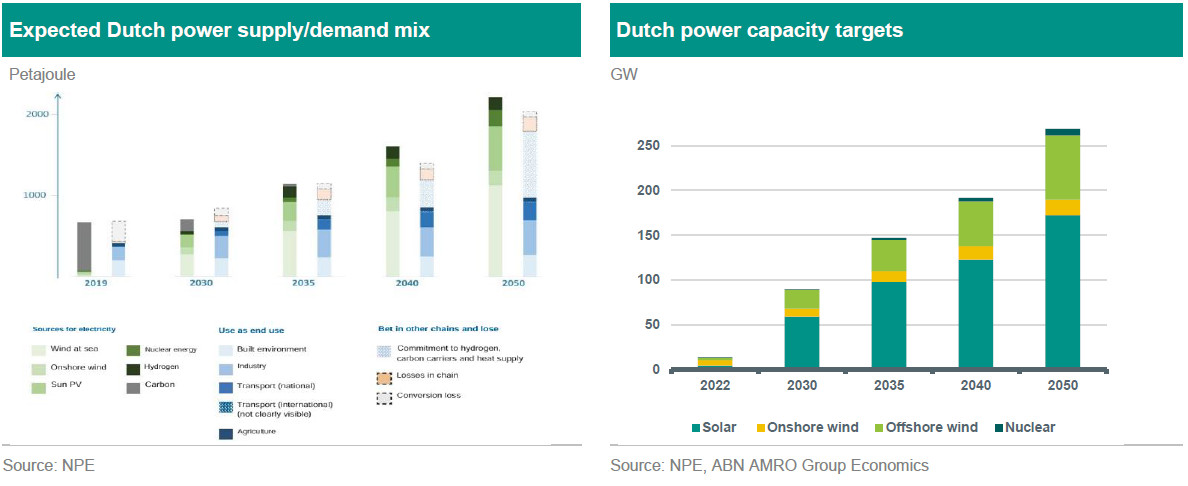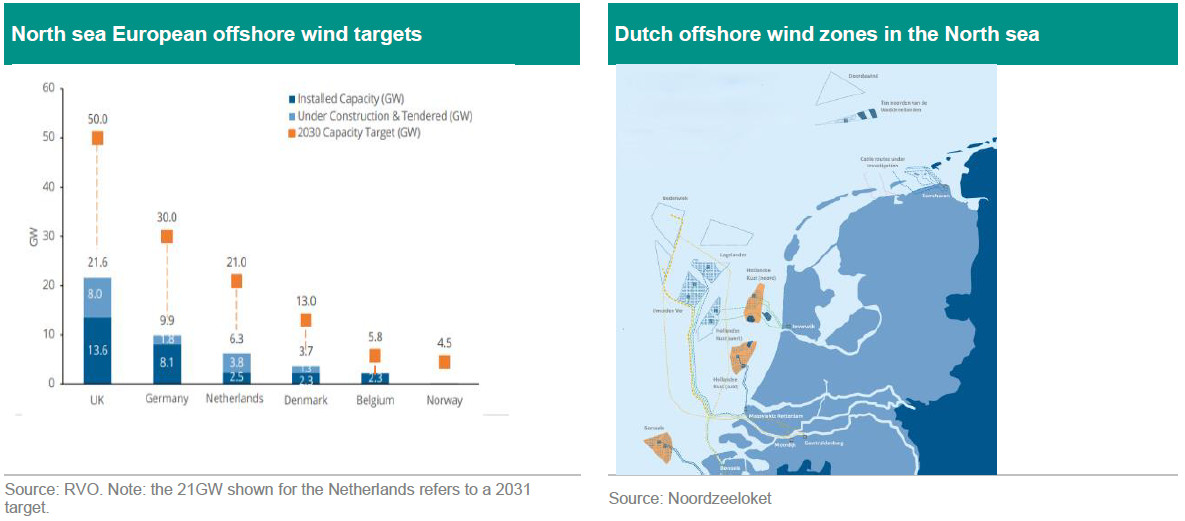ESG Economist - Ecology weighs most heavily in offshore wind tenders

The Netherlands has ambitious emission reduction targets for power generation, with offshore wind being a main pillar of the future power mix. The Dutch government identified three wind farm zones with eight designated areas to meet offshore wind capacity targets. The allocation of these areas is based on tendering processes, where developers compete for permits. The Dutch government revisited the design of these offshore tenders. The new tendering process is focused on non-price criteria with highest weight attributed to ecology. Accordingly, bids that minimize the ecological negative impacts over the lifetime of the wind farm, along with incorporating ecological monitoring and research, increase their chances of winning under the new tendering process.
Introduction
The core of the energy transition process is the switch towards renewable resources for power generation. Accordingly, wind and solar are set dominate the electricity mix in many countries across Europe. Furthermore, embedding renewable power in the energy mix became one of the key pillars for European energy security and an urgent priority following the energy crisis triggered by the Russian invasion to Ukraine in February 2022. In this note, we zoom into the current status of offshore wind in the Netherlands, its targets, challenges, and recent developments, with the latter focused on the incorporation of non-price criteria, such as ecological requirements, in the tendering process.
Dutch emission and capacity targets
Currently, there is more than 4GW of offshore installed capacity in the Netherlands. The goal is to reach an installed capacity of 21GW, 50GW, and 70GW by 2031, 2040 and 2050, respectively. Targets for different European countries in 2030 are shown in the left hand chart below. To meet these targets, the Dutch government identified three wind farm zones with eight designated areas (Ijmuiden Ver Gamma, Nederwiek 1,2,3, Lagelander 1,2, Ten Noorder van de Waddeneilanden, Doordewind) in the Review of the North Sea Programme (see map in the right hand chart below). These areas are also called acceleration areas for offshore wind. The government allocates these areas to different developers depending on the outcome of a tender process, where developers compete for permits.


New tendering process with a focus on ecology
Besides a positive role in reducing emissions and meeting climate targets, offshore wind farms can also create negative ecological impacts, such as mortality and ecosystem disturbance for migrating birds or different species living in the sea. These started to be taken into account by the Dutch government when awarding tenders. Offshore wind farms may also have positive ecological effects by providing hard substrate that help the flourishment of some species.
Permits to offshore wind projects are conventionally awarded through a tendering process that is coordinated by the government with price as the main determinant for the winner. The Dutch government recently revisited the auction design for offshore wind process emphasizing, a non-price criteria on top of the already existing pre-qualification criteria. The non-price criteria include, for example, mitigation measures for negative ecological impacts or nature enhancement measures. Accordingly, tenders for offshore wind are now based on a mix of requirements with points system. For instance, the tender Ijmuiden ver alpha area in the 1st quarter of 2024 has a total of 400 points allocated across different criteria as the following: financial aspects (up to 60 points); circularity, use of materials, environmental impact at design, build and decommissioning of the wind farm (40 points); security realization of windfarm (40 points); ecology (180 points); contribution to energy system in MWh (40 points); and international responsible business conduct (40 points). This example shows the dominance of ecological aspects, which has a 45% weight, compared to only 15% to financial aspects, which used to have the largest weight in the success of the tender. That is, bids that minimize the ecological negative impacts over the lifetime of the wind farm, along with incorporating ecological monitoring and research, increase their chances of winning under the new tendering process.
The accumulated ecological effects of the construction and operation of wind farms on the population of protected species in the North sea, such as bird, bats, and marine mammals, have been studied extensively under the Wozep Ecological Programme (see more ).
Other developments in the North sea
The North Sea Agreement, drawn between the Dutch government and different stakeholders in 2020, incorporated elements around maritime spatial planning, nature conservation and the sustainable energy production and food extraction. It resulted in the designation of the new areas for wind farms that focus on energy generation in the northern part of the country, and fisheries areas in the southern part. The agreement also involved targeting a 15% of marine protected areas by 2030. The agreement further included a “start stop procedure”, which means that wind turbines will be stopped during the mass migration of birds to avoid collusion with bird and bats.
Furthermore, within the North Sea Dialog, an assessment framework for Best Available Techniques (BBT) is being prepared. BTT aims at making use of the best effective and cost efficient techniques available for ecology. Additionally, newest tenders are expected to include research and monitoring obligation for wind operators.
Conclusion
The Netherlands has ambitious emission targets for its power sector. To meet these targets, building up capacity in offshore wind is essential as it is set to have a prominent role in the future power mix. The Dutch unique access to the North sea helps in reaching intended capacity goals. However, offshore wind is associated with negative ecological effects. Accordingly, the Dutch government revisited the design of offshore wind tenders. The new tendering process is focused on a non-price criteria with highest weight attributed to Ecology. Accordingly, bids that minimize the ecological negative impacts over the lifetime of the wind farm, along with incorporating ecological monitoring and research, increase their chances of winning under the new tendering process.
